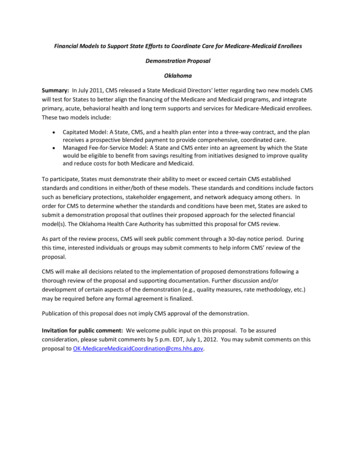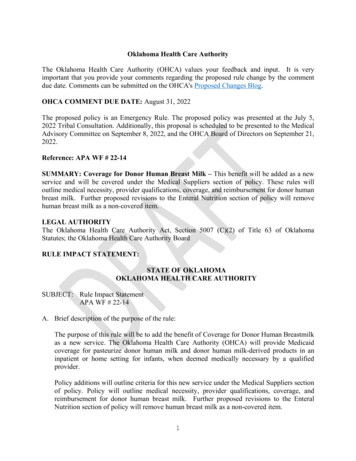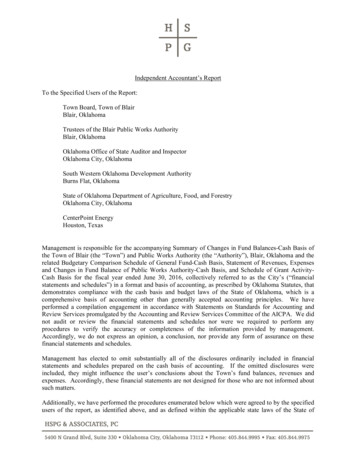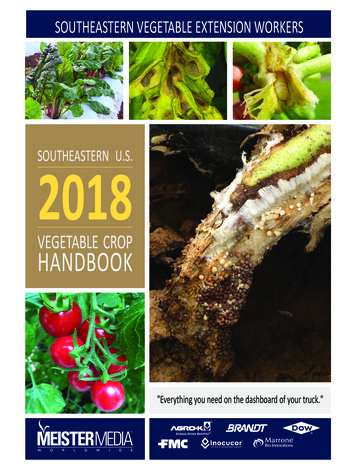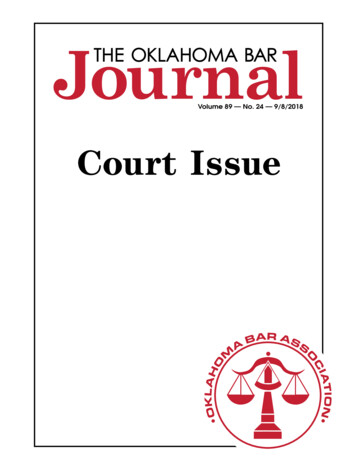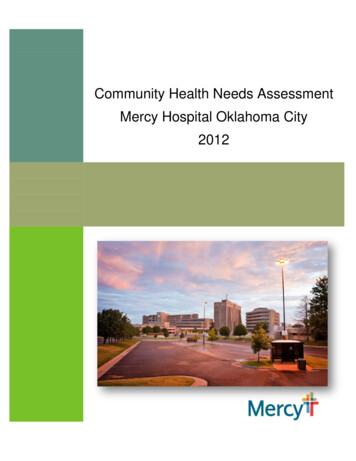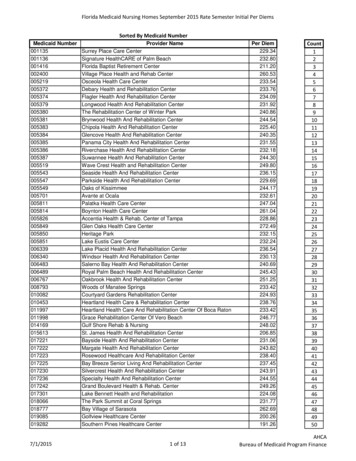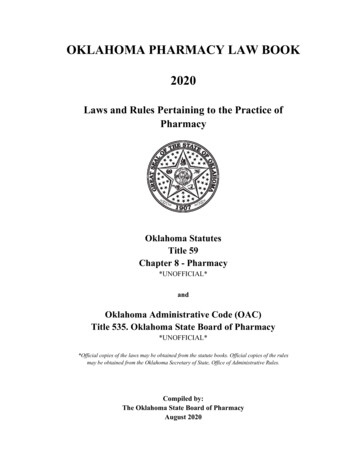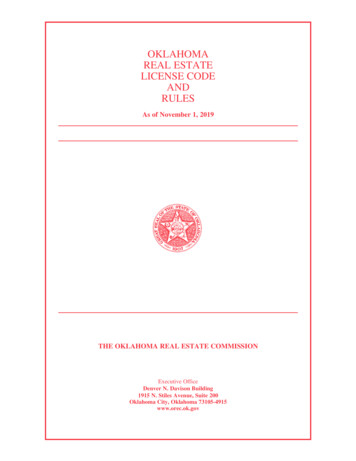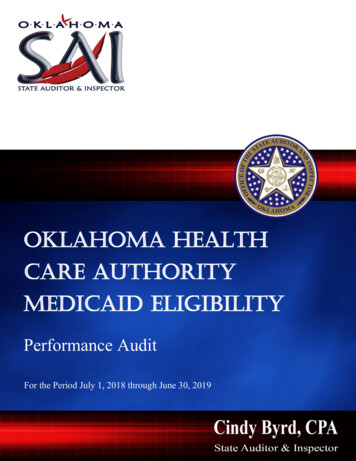
Transcription
Oklahoma healthCare authorityMedicaid eligibilityPerformance AuditFor the Period July 1, 2018 through June 30, 2019
Audit Report of theOklahoma Health Care AuthorityMedicaid EligibilityFor the PeriodJuly 1, 2018 through June 30, 2019This publication, issued by the Oklahoma State Auditor and Inspector’s Office as authorized by 74 § 212(C) and213.2(B), has not been printed, but is available on the agency’s website (www.sai.ok.gov) and in the OklahomaDepartment of Libraries Publications Clearinghouse Digital Prairie Collection audits/search), pursuant to 65 O.S. § 3-114.
EXECUTIVE SUMMARYOklahoma Health Care AuthorityMedicaid EligibilityFiscal Year 2019PROGRAM IMPACT & ENGAGEMENT BACKGROUNDMedicaid is a jointly funded federal-state program that provides health care coverageand services to eligible low-income individuals and families with children.As of June 30, 2019, approximately 1 million Oklahomans were enrolled in theMedicaid program (25% of our population) and received 4.7 billion in services.Medicaid is Oklahoma’s largest state appropriated program, and its cost is growingannually.STATE FISCAL YEAR 2019 APPROPRIATIONS 7.5 BILLIONTotal OHCAAppropriations, 1.1 billion, 13%Total Other StateAgencyAppropriations, 7.5 billion, 87%OHCA FUNDING FOR STATE FISCAL YEAR 2019Total SFY 19 OHCAOther Funding 1.4 billion, 24%Total SFY 19OHCA StateAppropriations, 1.1 billion, 19%Total SFY 19 OHCAFederal Funding, 3.3 billion, 57%
In response to the Governor’s request, this audit was performed to assess whetherOklahoma Health Care Authority (OHCA), the agency that administers Medicaid inOklahoma, has sufficient controls in place to ensure that only eligible individuals wereenrolled in the Medicaid program and those individuals were enrolled and disenrolledin a timely manner, in accordance with laws and regulations, in state fiscal year 2019.The populations tested included:TotalRecipientsTotal Claims ValueSample SizeTestedMAP MAGI recipients(OHCA)733,196 2,004,473,535184MAP Non-MAGIrecipients (OKDHS)182,647 2,306,734,463184CHIP MAGI recipients(OHCA)211,921 348,620,899184140 1,839,6917PopulationCHIP TEFRA recipients(OHCA/OKDHS)Included in the CHIPpopulations on the next page.We tested the maximum sample for the population size in accordance with GenerallyAccepted Auditing Standards.WHAT WE FOUNDThe findings noted throughout the report are related to key factors in the eligibilitydetermination process and the weaknesses detailed have allowed ineligibleindividuals to receive benefits.Limited electronic data, along with inadequate income support, were the primarydeficiencies noted specifically in the MAGI population. The following charts representthe percent of claims paid where income was verified, not verified often enough, ornot verified at all:
MAP (MAGI) ed37%IncomeNotVerifiedOftenEnough44%CHIP (MAGI) ifiedOftenEnough72%The control deficiency of not verifying income as required resulted in noncompliancein both the MAP and CHIP MAGI populations and deviations in the CHIP population.Details include: Oklahoma Employees Security Commission (OESC) is the only source ofelectronic wage data used to verify income. Additional data sources areavailable through the Federal Data Services Hub (Hub) for verifying individuals’information. The Hub contains additional data such as IRS information. Electronic wage data from OESC is not being used to verify income asfrequently as required. An estimated 44% of the MAP and 72% of CHIP claimsmay have paid on behalf of recipients whose income was not checked as often asit should have been. As a result, a projected 29.7 million in CHIP claims were paid onbehalf of ineligible recipients. Income is not verified for an estimated 37% of the MAP and 28% of the CHIPclaims paid on behalf of the follow categories individuals: self-employed, work out of state, work for the federal government, orclaim zero income, which accounted for approximately 21% of the MAPand 14% of the CHIP claims paid. those receiving pregnancy-related services, which accounted forapproximately 11% of the MAP and 2% of the CHIP claims paid. some non-applicants or their spouses who do not provide their SocialSecurity Numbers or other identifying information when applying forbenefits for their dependents; therefore, income could not be verifiedthrough the data exchange. This accounts for approximately 5% of theMAP and 12% of the CHIP claims paid.
The control deficiency and noncompliance noted for the MAP Non-MAGI populationinclude: IRS restrictions on SSA data: Social Security benefits, with the exception ofSupplemental Security Income (SSI), are considered income, and therefore fallunder the IRS Code 26 USC 6103 - Confidentiality Disclosure of Returns andReturn Information. In addition, the Computer Matching and Privacy ProtectionAct Agreement (CMPPS) states that “State Agencies will not use or redisclose thedata disclosed by SSA for any purpose other than to determine eligibility, for orthe amount of, benefits under the state-administered income/health maintenanceprograms.” Due to our inability to view this critical piece of financial datafrom an independent source, we had to rely on information maintained in casefiles in determining eligibility. Data exchanges with other entities are not consistently run at the requiredfrequency, and discrepancies noted through data exchanges are not alwaysresolved within the required 45-day timeframe. This could result in ineligiblerecipients not being identified before claims are paid. Additional issues were identified related to case file completeness, verificationprocedures, and compliance with pertinent laws and regulations. Inconsistentand incomplete case notes caused us some difficulty in determining eligibility. Inaddition, recipients can have multiple case files if they receive benefits from otherfederal assistance programs (companion cases). In some instances, the recipient’sinformation, such as applications and renewal notices, was placed in theincorrect case file.Figures were calculated using statistical sampling and projection methodology under expertguidance; details are included in the report.SOLUTIONSAs the State’s Administrator of Medicaid funds, OHCA is required to spendprogram funds as directed by federal and state laws and regulations. Withexpenditures growing, OHCA should take the necessary steps to ensure benefits areonly being provided to eligible individuals.Recommendations for OHCA are detailed in the report and include the following: Review the current controls in place in the eligibility system and updaterelevant processes, including these steps:oDesign and implement more aggressive procedures to verifyeligibility prior to certifying an applicant as eligible for the program.oTake steps to mitigate the risk of payments to ineligible recipients byexpanding types of electronic wage verification systems. Currently,only data from the OESC is being utilized. The data from OESC islimited to approximately 48% of the OHCA applicant population,
while leaving approximately 36% of the applicants to self-attestationwithout any other verification.One option is to utilize the Federal Data Services Hub (Hub). TheHub is a tool built by the Internal Revenue Service (IRS) and Healthand Human Services (HHS). It combines data on income andemployment from IRS records, health and entitlements from HHSrecords, identity from Social Security, citizenship from Departmentof Homeland Security records, criminality from Department ofJustice records, residency from state records, and other sources. Thissystem will provide timely, accurate information for wageverification of applicants.oIncorporate additional steps for eligibility verification rather than justthe minimum required by CMS. While CMS sets minimumrequirements for determining eligibility, there is no federalrestriction to prevent OHCA from designing internal controls andprocesses that will further ensure payments are made only foreligible recipients. These should include: documented income verification (using all appropriatesources) and collection of personally identifying informationfor all required applicants,timely wage data verification, andupdating the MMIS system to verify wage informationreceived from OESC on a quarterly basis to determinecontinued eligibility of individuals. Fully implement the HOPE Act which was passed by the OklahomaLegislature and became effective on November 1, 2017. Ensure the required conditions of eligibility are met in order to comply with42 CFR § 435, OAC 317:35, and the State Plan. Collaborate with OKDHS, provide additional staff training, and update theService Agreement, policies, and procedures as necessary, to comply with 42CFR § 431.10(c)(2) and 42 CFR § 431.10(c)(3)(ii). These efforts should ensure:oooodata exchanges with other entities are performed at the requiredfrequency,discrepancies are cleared in a timely manner,required case documentation is retained, andtimely notifications of eligibility decisions are provided as required.Additional requests from the Governor that would strengthen the audit process: Request that the Internal Revenue Service allow auditors access to incomeinformation and other independent sources of information (e.g. the Hub) so thatsuch information can be utilized when redetermining eligibility.See full report at http://www.sai.ok.gov
June 25, 2020TO GOVERNOR KEVIN STITT,KEVIN CORBETT, CHIEF EXECUTIVE OFFICER and the OKLAHOMA HEALTHCARE AUTHORITY BOARDWe present the audit report of the Oklahoma Health Care Authority–Medicaid Eligibility forthe period July 1, 2018 through June 30, 2019. The goal of the State Auditor and Inspector is topromote accountability and fiscal integrity in state and local government. Maintaining ourindependence as we provide this service to the taxpayers of Oklahoma is of utmost importance.We wish to take this opportunity to express our appreciation for the assistance and cooperationextended to our office during our engagement.This report is a public document pursuant to the Oklahoma Open Records Act (51 O.S. § 24A.1et seq.), and shall be open to any person for inspection and copying.Sincerely,CINDY BYRD, CPAOKLAHOMA STATE AUDITOR & INSPECTOR
Oklahoma Health Care AuthorityMedicaid EligibilityPerformance AuditTable of ContentsOverview of Medicaid . 1Scope and Methodology . 4Objective and Conclusion . 6Findings . 7Recommendations. 22Appendix A: Eligibility Background Information . 23Appendix B: Scope and General Methodology . 28Medicaid Acronyms . 32Views of Responsible Officials . Last 4 pages of report
Oklahoma Health Care AuthorityMedicaid EligibilityPerformance AuditOverview ofMedicaidMedicaid, also referred to as the Medical Assistance Program (MAP), is ajointly funded federal-state program that provides health care coverageand services to eligible low-income individuals and families withchildren. Medicaid is administered at the federal level by the Center forMedicare and Medicaid Services (CMS) under Title XIX of the FederalSocial Security Act 1, and administered at the state level by the OklahomaHealth Care Authority (OHCA, or the Authority) under the OklahomaAdministrative Code (OAC) 317:35. 2Because each state establishes and administers its Medicaid program,there is considerable variation from state to state. Each state specifies thenature and scope of its Medicaid program through a state plan. 3The Affordable Care Act (ACA) requires states to calculate the income formost nondisabled, nonelderly applicants using a uniform method basedon modified adjusted gross income (MAGI) 4, which is derived from afederal tax-based definition of income. States have more flexibility incalculating incomes for individuals whose eligibility is determined on thebasis of age or disability, because their income is not required to becalculated using MAGI-based methods.Federal regulations 5 require states to provide all eligible recipients certainbasic services, including but not limited to inpatient and outpatienthospitalizations, physicians, and rural health clinic and nursing facilityservices.OklahomaMedicaidIn administering Oklahoma's Medicaid program, known as SoonerCare,OHCA sets guidelines regarding eligibility and services in Oklahoma.The official eligibility requirements are identified in the State Plans andWaivers, which reference to the codified requirements in 42 Code ofFederal Regulations (CFR) section 435.In addition to the MAP, the Children’s Health Insurance Program (CHIP)provides health coverage to children in families with incomes too high toqualify for Medicaid but who cannot afford private health coverage. LikeMedicaid, CHIP is a federal-state program.1Social Security ActOklahoma Administrative Code342 CFR § 431.10 The state plan is a formal, written agreement between a state and the federal government,submitted by the single state agency and approved by CMS, describing how that state administers its Medicaidprogram.4The ACA definition of MAGI under the Internal Revenue Code Section 36B(d)(2)(B), and 42 CFR § 435.603(e)542 CFR § 440 – Services: General Provisions21
Oklahoma Health Care AuthorityMedicaid EligibilityPerformance AuditAccording to State Fiscal Year (SFY) 2019 data 6, eligibility determinationsfor approximately 75% of the Medicaid recipients were made through theautomated online system at OHCA; the other 25% were performedmanually at the Oklahoma Department of Human Services (OKDHS)based on applications submitted in person, by mail, or by telephone.APPLICATION TYPEManual25%Automated75%Nearly 1 million Oklahomans were enrolled in the Medicaid program asof June 30, 2019, which is about 25 percent of Oklahoma’s population. 7As illustrated in the following table 8, 3.3 billion was federally funded toMedicaid in Oklahoma in federal fiscal year 2019, and approximately 1.7billion was state appropriated. Medicaid is Oklahoma’s largest stateappropriated program.6We utilized the SoonerCare Fast Fact Sheets for Enrollment form the OHCA website athttp://www.okhca.org/research.aspx?id 2987 and averaged each month for SFY 2019.7According to the Census Bureau at o/popest/2010s-statetotal.html, Oklahoma’s population estimate was 3,956,971 at July 1, 2019. According to the OHCA 2019 AnnualReport, the total population enrolled in the Medicaid was 998,209. (998,209/3,956,971 0.25)8OHCA – SFY 2019 Annual Report Appendix (Totals are based on a federal fiscal year and represent all expendituresrelated to the Medicaid program.), online at http://www.okhca.org/research.aspx?id 87.2
Oklahoma Health Care AuthorityMedicaid EligibilityPerformance AuditSharedEligibilitySystemStates are required to have an income and eligibility verification systemfor determining Medicaid eligibility, and upon CMS’s request, averification plan describing the state agency’s policies and procedures forimplementing the eligibility verification requirements. 9 The plan isreviewed and accepted by CMS and must specifically include how anindividual’s eligibility information, such as citizenship, social securitynumber (SSN), and residency will be verified. Oklahoma’s methods forverifying applicants’ information are outlined in the State VerificationPlan. 10Oklahoma operates a dual-eligibility determination system. OHCA usesan online application system to perform eligibility determinations for theportion of the Medicaid population whose eligibility is based on MAGI,as outlined in OAC 317:35-5-63 (a). 11 This application system is asubsystem of OHCA’s benefits payment system (the MedicalManagement Information System or MMIS).While Oklahoma’s Medicaid program is administered by OHCA, aportion of the eligibility determination functions is delegated to OKDHS.A service agreement with OKDHS is in place to assure cooperation andcollaboration between OHCA and OKDHS in performance of theirrespective duties to provide health care to eligible recipients.The OKDHS staff works in partnership with the Authority in determiningeligibility for those receiving other government assistance and thoseconsidered as the Aged, Blind, and Disabled (ABD) population. 12Eligibility for these individuals is based on a non-MAGI (no modifiedadjusted gross income) methodology. Once an applicant is deemedeligible through OKDHS, payments for medical services are processedthrough MMIS.Additional detailed information related to methods of verification andother facets of the Oklahoma Medicaid program is located in Appendix A.CFR, 435.945(j) Verification plan. The agency must develop, update as modified, and submit to the Secretary,upon request, a verification plan describing the verification policies and procedures adopted by the State agency toimplement the provisions set forth in §§ 435.940 through 435.956 of this subpart in a format and manner prescribedby the Secretary.10 State Verification Plan11Details are listed in Appendix A12The criteria for determining eligibility for the ABD population is defined by the Social Security Administration. SeeSupplemental Security Income (SSI) Eligibility Requirements online at https://www.ssa.gov/ssi/text-eligibilityussi.htm9 423
Oklahoma Health Care AuthorityMedicaid EligibilityPerformance AuditScope & MethodologyAuditRequestOur audit was conducted in response to the Governor’s request, asauthorized by 74 § 212(C) and § 213.2(B). The purpose of the audit was toassess whether OHCA has sufficient controls in place to ensure onlyeligible individuals are enrolled in the Medicaid program, and todetermine if individuals were enrolled and disenrolled in a timelymanner, in accordance with laws and regulations.This audit was performed in conjunction with the 2019 Single Audit. 13The Office of Management and Budget issues guidance in the ComplianceSupplement, which identifies important compliance requirements thatthe federal government expects to be considered as part of such anaudit. 14 Because sufficient, appropriate audit evidence supporting theeligibility compliance requirement regarding MAP and CHIP could notbe obtained, a determination of whether the State of Oklahoma compliedwith the requirement could not be made. Therefore, the State ofOklahoma 2019 Single Audit indicates a disclaimed opinion on eligibility.In addition, material weaknesses were noted and reported for theeligibility control system as a whole.ScopeLimitationAs reflected above regarding the Single Audit, we determined that caserecords for some recipients lacked crucial documentation to support selfreported income which is needed to redetermine eligibility; therefore, wewere unable to determine if Medicaid benefits should have been paid onbehalf of those recipients.SampleMethodTo determine compliance with applicable eligibility laws and regulations,we evaluated the OHCA and OKDHS controls over the eligibilitydetermination process, and redetermined eligibility for a statisticalsample by randomly selecting 184 Medicaid recipients from each of threeseparate data sets, and judgmentally selecting a sample of seven TEFRArecipients 15, for a total of 559 cases. We then reviewed pertinentdocumentation in each recipient’s electronic case records. Thepopulations and samples referred to throughout the report follow:13Organizations based in the United States with expenditures of federal funding of 500,000 or more ( 750,000 ormore for fiscal years beginning on or after December 26, 2014) within the organization’s fiscal year are required tosend an audit report to the Office of Management and Budget, in accordance with the Single Audit Act, as amended,and the Office of Management and Budget implementing guidance. See 31 U.S.C. §§ 7501-7507; 2 C.F.R., pt. 200,subpart. F. (2019) (as added by 78 Fed. Reg. 78590, 78608 (Dec. 26, 2013).14 2019 Compliance Supplement online at ederal-financialmanagement/15See further explanation in Appendix B.4
Oklahoma Health Care AuthorityMedicaid EligibilityPerformance AuditTotalRecipientsTotal Claims ValueSample SizeTestedMedicaid MAGIrecipients (OHCA)733,196 2,004,473,535184Medicaid Non-MAGIrecipients (OKDHS)182,647 2,306,734,463184CHIP MAGI recipients(OHCA)211,921 348,620,899184140 1,839,6917PopulationCHIP TEFRA recipients(OHCA/OKDHS)Included in the CHIPpopulations below.DOLLAR AMOUNT BY PROGRAMCHIP(OHCA/OKDHS), 350,460,590 ,8%MAGI (OHCA), 2,004,473,535 ,43%Non-MAGI(DHS), 2,306,734,463 ,49%RECIPIENT TOTAL BY PROGRAMCHIP(OHCA/OKDHS),212,061, 19%Non-MAGI(DHS), 182,647,16%MAGI (OHCA),733,196, 65%Additional detailed methodology and applicable auditing standards arediscussed in more detail in Appendix B.5
Oklahoma Health Care AuthorityMedicaid EligibilityPerformance AuditObjective1. Determine whether OHCA complied with 42 CFR § 435, OAC 317:35, andthe State Plan when enrolling individuals to Medicaid (MAP) andChildren’s Health Insurance Program (CHIP).2. Determine whether individuals enrolled in the MAP or CHIP programsmeet state and federal eligibility requirements according to the same lawsand regulations identified in objective 1.3. Determine whether OHCA complied with timeliness requirements in 42CFR § 435.912, 42 CFR § 435.916, and 42 CFR § 435.917 when adding orremoving recipients from the MAP and CHIP program.Overall ConclusionOverall, OHCA does not have adequate internal controls in place toensure compliance with federal laws and regulations that require onlyeligible participants receive Medicaid and CHIP benefits. OHCA madepayments on behalf of Medicaid recipients who did not meet, or may nothave met, federal and state eligibility requirements.Although the Authority is adding individuals to the program in a timelymanner, in accordance with CFR § 435.912, 42 CFR § 435.916, Oklahomais the only state to approve 100% of MAGI applications within 24hours. Federal regulations allow the Authority up to 45 days to verifyan applicant’s information, if necessary. Utilizing additional days toverify the applicant’s information would give the state better leverage toensure only eligible applicants are receiving services.At the time the Authority determines individuals to be ineligible, they areremoved from the program timely in accordance with CFR § 435.912, 42CFR § 435.916.In some instances, individuals did not receive notifications regarding thedecision made about their eligibility in accordance with 42 CFR § 435.917.The following report discusses the deficiencies noted, opportunities forimprovement, and recommendations based on the applicable laws andregulations.6
Oklahoma Health Care AuthorityMedicaid EligibilityPerformance AuditFindingsWe reviewed the State Verification Plan, significant laws and regulations,and the federal program requirements in detail, then identified thesignificant controls 16 related to criteria for the eligibility determinationprocess. As discussed earlier, there are significant differences between theeligibility determination processes at OHCA and at OKDHS. Whileeligibility determinations made at OHCA are specific to the MAGIpopulations and made through an automated online system, the OKDHSprocesses are specific to the non-MAGI populations and eligibilitydeterminations are made manually by a Social Service Specialist.Because the processes are different, the internal controls are expected tobe different. However, all controls should be adequately designed andoperating effectively to ensure: eligibility determinations are made in accordance with applicablelaws and regulations;only eligible applicants receive benefits;current recipients continue to be eligible at the time ofredetermination; andrecipients are added to or removed from the program in a timelymanner, in accordance with applicable laws and regulations.We identified control deficiencies and areas of noncompliance at bothOHCA and OKDHS.Wage Data NotVerified at theRequiredFrequencyFederal guidance requires states to participate in the state income andeligibility verification system (IEVS) and request financial informationfrom other agencies and other state and federal programs, to the extentthat such information is useful to verify the financial eligibility of anindividual. 17 This includes information related to wages, net earningsfrom self-employment, and unearned income, as well as resources fromInternal controls are policies, procedures, and activities designed to assist an entity in meeting an objective.Controls can be automated or manual and examples include reconciliations; segregation of duties; review andapproval authorizations; safeguarding and accountability for assets; and preventing or detecting error or fraud.Controls help ensure appropriate financial reporting, the achievement of operational objectives, and compliance withapplicable laws, regulations, and written agreements.1742 U.S.C. 1320b–7 online at https://www.govregs.com/uscode/42/1320b-7; 42 CFR § 435.948 (a)(1)167
Oklahoma Health Care AuthorityMedicaid EligibilityPerformance Auditthe State Wage Information Collection Agency, the Internal RevenueService (IRS), and the Social Security Administration (SSA).Federal regulations also provide standards under which incomeinformation obtained through electronic data sources is consideredreasonably compatible 18 with income information provided by or onbehalf of an individual. 19Federal law requires that income be verified at the time of applicationand then again at redetermination. 20 The law states that “the agency mustpromptly evaluate information received or obtained by it in accordancewith regulations to determine whether such information may affect theeligibility of an individual or the benefits to which he or she is entitled.” 21In Oklahoma, income provided by an applicant is self-attested at the timeof application and if the amount falls below the federal poverty level(FPL) based on the applicant’s household size, with less than a 5%compatibility limit, they are determined eligible. Income is then verifiedpost enrollment from quarterly wage data received from the OklahomaEmployment Security Commission (OESC). Income is verified again atthe time of renewal (within 12 months of the application date).Information from OESC is the only source of electronic wage datarequested from another agency to verify an individual’s incomeeligibility. 22 OESC data only contains reported wage information fromOklahoma employers. It does not include income from selfemployment, out-of-state employers, or federal employers.Income is confirmed using data from a full quarter of wages whenverifying an applicant’s income. Therefore, if an individual applies forservices in the 2nd quarter of a year, their income may not be verified untilthe 4th quarter. This is because the first available full quarter of wage dataafter application is the 3rd quarter (July-September) data. This data willnot be provided to OHCA until the 4th quarter (October). See example:18The term “reasonable compatibility” refers to a Federal requirement (effective January 1, 2014) that prohibits Statesfrom requiring Medicaid applicants to provide documentation except in cases in which applicants’ self-reporteddocumentation was not reasonably compatible with information in government databases (42 CFR §435.952(c)). Inaccordance with this requirement, the State agency established its reasonable compatibility threshold at a 10-percentdiscrepancy between the applicant’s self-attested income and the same individual’s income as subsequently reportedby his or her employer. The State agency also established a 90-day reasonable opportunity period for an applicant torespond to the State agency regarding income discrepancies.19 42 CFR § 435.95220 42 CFR § 435.9482142 CFR § 435.952 (a)22According to OHCA management, the online enrollment for OHCA existed prior to ACA and the Hub. Seediscussion later in this report section.8
Oklahoma Health Care AuthorityMedicaid EligibilityPerformance AuditQuarter 3(July-September):Full Quarter ofWage DataQuarter 2(April-June):Application for MedicaidQuarter 4(October-December):Quarter 3 Data reviewedby OHCAWe reviewed wage data closest to the date of service selected for 237recipients 23 and noted that OHCA only verified a recipient’s incometwice a year, even though information from OESC was provided morefrequently (quarterly).A recipient’s income could change throughout the year without it beingdetected in a timely manner by OHCA, because wage informationreported by the recipient is not verified at the frequency wage data isobtained. Therefore, a recipient’s income could exceed the federal povertylevel, making the recipient ineligible for Medicaid benefits.A control deficiency was noted for the following:MAP Details In 85 of 184 (46%) case files tested, the quarterly wage data wasnot compared to household income often enough to determine ifthe recipient remained eligible throughout the year.CHIP Details In 152 of 184 (83%) case files tested, the quarterly wage data wasnot compared to household income often enough to determine ifthe recipient remained
Oklahoma Health Care Authority (OHCA) , the agency that administers Medicaid in Oklahoma, has sufficient controls in place to ensure that only eligible individuals we re enrolled in the Medicaid program and those individuals were enrolled and disenrolled in a timely manner, in accordance with laws and regulations , in state fiscal year 2019.

